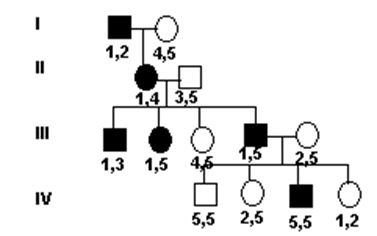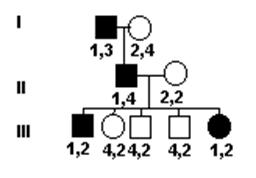1- It has been suggested that cystic fibrosis (autosomal recessive) has a high prevalence in some populations because heterozygotes are resistant to the effects of chloride-secreting diarrhea. This is best described as an example of?
2- Which of the following is not true of genetic diagnosis using fetal cells in the maternal circulation??
3- Using linkage analysis, you have mapped a disease gene to a 1 magabase (Mb) region of a specific chromosome. Which of the following approaches would be least useful in identifying and cloning the gene??
4- Which of the following is a major difference in the mechanisms for generating diversity in T cell receptors and B cell immunoglobulins (antibodies)??
5- Why is there so much MHC (major histocompatibility locus) allelic diversity among individuals in populations??
6- A likely explanation for autoimmune disease is?
7- A Northern Blot is used to?
8- Which of the following is true of autosomal dominant breast cancer??
9- Which of the following is not true of type 2 diabetes (non-insulin dependent diabetes)?
10- Huntington disease is thought to be caused by a gain-of-function mutation. Which type of gene therapy would be potentially effective in treating this mutation??
11- A neural tube defect (anencephaly or spina bifida) could be detected by?
12- Which of the following is not an indication for prenatal diagnosis by amniocentesis??
13- Which of the following would not be involved in a quantitative trait locus analysis??
14- Which of the following genetic abnormalities is not associated with Alzheimer disease??
15- Match each phrase with the most appropriate description. Answers can be used more than once. *Age-related macular degeneration?
16- Match each phrase with the most appropriate description. Answers can be used more than once. *Interact with the RadS51 DNA repair system?
17- Match each phrase with the most appropriate description. Answers can be used more than once. *Transcription factors involved in limb development?
18- Match each phrase with the most appropriate description. Answers can be used more than once. *Maturity onset diabetes of the young (MODY)?
1- A population of 50 individuals has been assayed for a 4-allele microsatellite polymorphism, and the following genotype counts have been obtained: Based on these genotype counts, what are the gene frequencies of alleles 1 and 2.
|
Genotype |
Count |
|
1,1 |
4 |
|
1,3 |
8 |
|
1,4 |
3 |
|
2,3 |
5 |
|
2,4 |
9 |
|
3,3 |
4 |
|
3,4 |
6 |
|
4,4 |
11 |
2- Continuing question 1: if this locus is in Hardy-Weinberg equilibrium, what is the expected genotype frequency for the 1,1 genotyp.
|
Genotype |
Count |
|
1,1 |
4 |
|
1,3 |
8 |
|
1,4 |
3 |
|
2,3 |
5 |
|
2,4 |
9 |
|
3,3 |
4 |
|
3,4 |
6 |
|
4,4 |
11 |
3- A linkage study has been performed in which recombination frequencies have been measured for a disease locus (D) and two marker polymorphisms (A and B). The estimated recombination frequencies for each pair of loci are: A-B = 0.15; A-D = 0.04; BD = 0.11. Based on these estimates, what is the order of the three loci on a chromosome? To which marker is the disease locus most closely linked?.
4- A man is affected with an X-linked dominant disorder. The penetrance of the disease genotype is 60%. What is the probability that his daughters will be affected with this disorder?.
5- Consider the accompanying pedigree, in which an autosomal dominant disease-causing gene is segregating. Each family member has been typed for a closely linked 2-allele RFLP. What is the risk that the offspring in generation III will inherit the disease-causing gene?.
6- In the accompanying pedigree, in which an autosomal recessive disease is segregating, each member has been typed for a closely linked 6-allele microsatellite polymorphism. The genotypes are shown in the autoradiogram. What is the risk that individual 7 will develop the disease?.
7- In the accompanying pedigree, each individual has been assayed for a microsatellite repeat polymorphism that is known to be linked to an autosomal dominant disorder that is being transmitted in this family. The polymorphism has five alleles, labeled 1,2,3,4, and 5. What is the recombination fraction for the disease locus and the liked microsatellite system?.
8- You are attempting to find a gene that causes autosomal dominant dysmelodia (this is a real condition -- tone deafness). You have chosen to label this gene as the D&M locus. Transmission of the D&M gene is shown in the accompanying pedigree. Family members have been typed for a 4-allele marker locus (alleles are labeled 1,2,3, and 4). Based on the genotypes in generation III, what is the LOD score for the hypothesis that the recombination fraction for the disease locus and the marker locus is zero?.
9- Your study has progressed, and a second family has now been studied and typed for the same polymorphic marker. You estimate the LOD score for this family, too. Considering the LOD scores in both families, how would you interpret your results?.
10- A woman affected with retinoblastoma has borne a pair of monozygotic twins. One of the twins developed two retinoblastomas before age 5, while the other twin has never developed a retinoblastoma. What is the most likely explanation for this?.
11- You are now employed by a well-known HMO, and a switch of babies in the hospital nursery is suspected. To determine whether "baby Smith" is truly the offspring of Mrs. Smith, the baby and Mrs. Smith have been typed for four VNTR systems (the other baby is not available for testing, and Mrs. Smith is unsure of the father of the baby). Mrs. Smith and the baby match for one allele in each of the four systems. The frequencies of the matching VNTR alleles in the general population are 0.01, 0.02, 0.05, and 0.1. To increase the accuracy of identification, mother and baby have also been sequenced for a portion of their mitochondrial DNA. They match for this sequence, too. This particular sequence is seen in 3% of the general population. Taking all of this information into account, what is the probability that a baby in the general population would have this combination of VNTR alleles and mitochondrial sequence?.
12- Consider the following prenatal diagnostic techniques: amniocentesis, chorionic villus sampling, and the testing of fetal cells in the maternal circulation. Rank these three tests in terms of their potential for causing fetal loss, from least potential to greatest..
Powered by Issa Aldababseh




